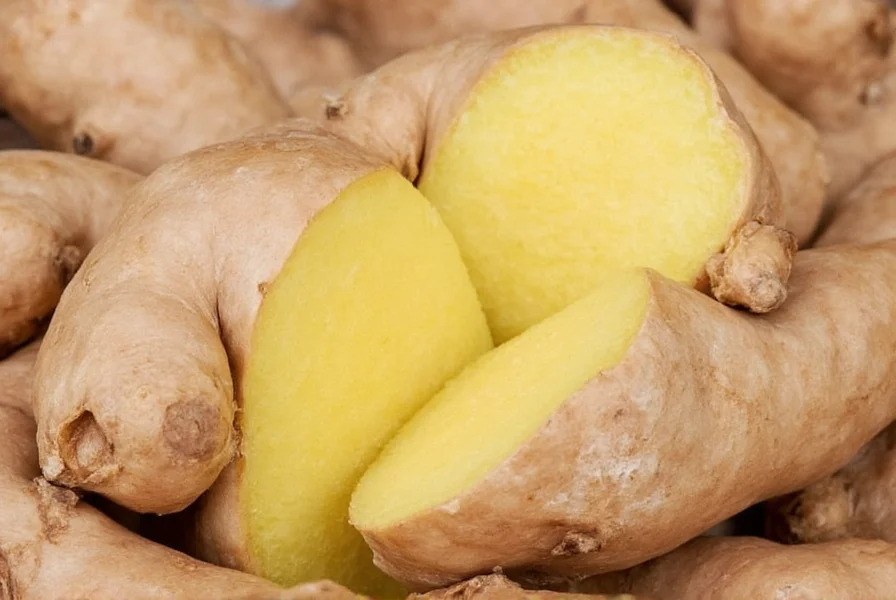Understanding Raw Ginger Consumption
Raw ginger root has been used for centuries in traditional medicine and culinary practices worldwide. Unlike cooked or processed ginger, raw ginger preserves its full spectrum of beneficial compounds, particularly gingerol, which transforms into zingerone when heated. This distinction makes raw ginger especially valuable for certain health applications.
Nutritional Profile of Fresh Ginger
One tablespoon (about 6 grams) of raw ginger contains:
| Nutrient | Amount per Serving | % Daily Value |
|---|---|---|
| Calories | 5 | 0% |
| Carbohydrates | 1.3g | 0% |
| Fiber | 0.1g | 1% |
| Vitamin C | 0.5mg | 1% |
| Magnesium | 2.4mg | 1% |
| Gingerol | Varies | N/A |
While the vitamin and mineral content appears modest, raw ginger's true value lies in its phytochemical composition. The compound gingerol gives raw ginger its characteristic pungency and provides most of its celebrated health benefits.
Health Benefits of Eating Raw Ginger Root
Consuming ginger in its raw form delivers maximum potency of its active compounds. Research shows raw ginger offers several evidence-based benefits:
- Digestive support: Raw ginger stimulates saliva and bile production, helping break down food more efficiently. Many people find relief from nausea, including morning sickness and motion sickness, by consuming small amounts of fresh ginger.
- Anti-inflammatory properties: The gingerol in raw ginger inhibits inflammatory pathways in the body, potentially reducing muscle pain and soreness after exercise.
- Immune system boost: Raw ginger contains compounds that may enhance immune function, particularly during cold and flu season.
- Blood sugar regulation: Some studies suggest raw ginger may help improve insulin sensitivity, though more research is needed in this area.

How to Prepare and Eat Raw Ginger
Proper preparation maximizes both flavor and benefits when consuming raw ginger:
- Selection: Choose firm, smooth ginger roots with tight skin. Avoid roots with wrinkles, soft spots, or mold.
- Peeling: Use a spoon to gently scrape off the thin skin rather than a vegetable peeler, which removes too much edible flesh.
- Cutting: Slice or grate ginger depending on your intended use. Thin slices work well for tea, while grated ginger incorporates better into dressings or marinades.
- Consumption methods:
- Add thin slices to hot water for ginger tea
- Grate into salad dressings or marinades
- Chew small pieces (about 1/4 inch) to relieve nausea
- Incorporate into smoothies for digestive benefits
- Make candied ginger using minimal sugar
Raw Ginger vs. Cooked Ginger: Key Differences
The preparation method significantly affects ginger's chemical composition and benefits:
- Raw ginger: Highest concentration of gingerol, providing maximum anti-nausea and anti-inflammatory effects. More pungent flavor.
- Cooked ginger: Heat transforms gingerol into zingerone, which is less pungent but still offers health benefits. Better for those with sensitive stomachs.
- Dried ginger: Contains shogaol, which has different bioavailability and potentially stronger anti-inflammatory properties than raw ginger.
For specific applications like nausea relief, raw ginger generally provides faster results due to its higher gingerol content. However, cooked ginger may be preferable for those with digestive sensitivities.
Potential Side Effects and Considerations
While raw ginger is safe for most people, certain considerations apply:
- Digestive discomfort: Consuming more than 4 grams of raw ginger daily may cause heartburn, gas, or stomach upset in sensitive individuals.
- Blood thinning: Ginger has mild blood-thinning properties. Those taking anticoagulant medications should consult their doctor before consuming large amounts.
- Gallstone concerns: Ginger may increase bile production, which could be problematic for people with gallstones.
- Pregnancy: While small amounts (up to 1 gram daily) are generally considered safe during pregnancy for nausea relief, pregnant women should consult their healthcare provider before regular consumption.

Recommended Daily Intake of Raw Ginger
Most health organizations suggest these guidelines for raw ginger consumption:
- General health maintenance: 1-2 grams (about 1/2 to 1 teaspoon grated) daily
- Nausea relief: 1 gram taken 20-30 minutes before potential nausea triggers
- Anti-inflammatory benefits: 2 grams daily, divided into multiple servings
- Maximum safe amount: 4 grams daily for most adults
It's important to note that individual tolerance varies. Start with small amounts (1/4 to 1/2 teaspoon) and gradually increase to assess your body's response when first incorporating raw ginger into your diet.
Who Should Limit Raw Ginger Consumption
Certain populations should exercise caution with raw ginger:
- People taking blood thinners like warfarin
- Individuals with bleeding disorders
- Those scheduled for surgery within two weeks
- People with gallstones
- Individuals with heart conditions taking beta-blockers
- Pregnant women beyond first trimester (consult physician)
If you have any underlying health conditions or take medications regularly, consult your healthcare provider before making raw ginger a regular part of your diet.
Practical Ways to Incorporate Raw Ginger
Here are simple methods to enjoy raw ginger's benefits:
- Ginger shots: Blend 1 inch ginger root with lemon juice and a small amount of honey
- Infused water: Add thin ginger slices to water and let steep for 2-4 hours
- Salad boost: Grate fresh ginger into vinaigrettes or directly onto salads
- Smoothie enhancer: Add 1/2 inch grated ginger to fruit smoothies
- Tea preparation: Steep 2-3 thin slices in hot water for 5-10 minutes
For those new to raw ginger, start with smaller amounts and gradually increase as your palate adjusts to its distinctive flavor profile.
Frequently Asked Questions
Is raw ginger better than cooked ginger for nausea relief?
Yes, raw ginger generally provides more effective nausea relief than cooked ginger. The compound gingerol, which is most abundant in raw ginger, has stronger anti-nausea properties. When ginger is cooked, gingerol converts to zingerone, which is less potent for nausea relief but still beneficial. For immediate nausea relief, chewing a small piece of raw ginger or drinking raw ginger tea typically works faster than cooked preparations.
How much raw ginger can I safely eat in one day?
Most health authorities recommend not exceeding 4 grams of raw ginger per day for adults. This equals approximately 1 tablespoon grated ginger or 2-3 one-inch slices. For general health maintenance, 1-2 grams daily is sufficient. People with sensitive stomachs may need to start with smaller amounts (1/4 to 1/2 teaspoon) and gradually increase. Those taking medications or with certain health conditions should consult their healthcare provider for personalized recommendations.
Does raw ginger lose its benefits if stored improperly?
Yes, improper storage can significantly reduce raw ginger's beneficial compounds. Fresh ginger root maintains its potency best when stored in the refrigerator, wrapped in a paper towel inside a resealable plastic bag. This method preserves gingerol content for 2-3 weeks. Freezing ginger preserves most compounds for up to 6 months. At room temperature, ginger begins losing potency within days as gingerol degrades. Peeled ginger deteriorates faster than unpeeled, so only peel what you'll use immediately.
Can children safely eat raw ginger?
Children over 2 years old can consume small amounts of raw ginger, but with important considerations. The recommended amount is no more than 1 gram per day for children ages 2-6, and 2 grams for children 7-12. Ginger may help with childhood nausea, but its strong flavor often requires dilution. Try adding small amounts to warm water with honey (for children over 1 year) or incorporating into fruit smoothies. Always consult a pediatrician before giving raw ginger regularly to children, especially those with medical conditions or taking medications.











 浙公网安备
33010002000092号
浙公网安备
33010002000092号 浙B2-20120091-4
浙B2-20120091-4